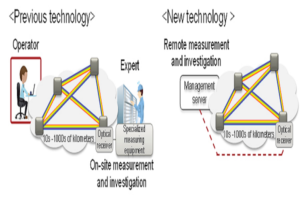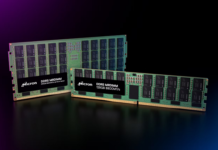
Communications traffic on the optical networks that sustain an ICT-powered society is expected to increase tremendously alongside the number of devices connected to the internet in the years ahead. In order to accommodate this volume of data, a number of new optical transmission technologies are being adopted one after another in optical networks, and it is believed that networks will become even more diverse and complex. Consequently, demand exists for technologies that will make it easier to build, operate and manage optical networks.
Issues
Previously, when building an optical network, or when problems arose in operating a network, it was necessary to send an expert in this field with expensive and specialized measurement equipment to a worksite, and conduct measurements and tests to determine the cause. In optical networks that aim to boost capacity and distance, the increasing complexity of types of optical transmission signals and device parameter settings means that building the network or fixing issues may require several days, leading to significant issues in quickly building and managing fiber-optic networks. As a result, demand has emerged for the development of technologies that can remotely monitor the status of optical networks in order to resolve these issues. There have been challenges, however, in measuring the information that network operators and managers need without relying on dedicated measurement devices due to the unique optical signal characteristics of newly-deployed optical transmission technologies.

Figure 1: Summary of the newly developed technology
About the Newly Developed Technology
Fujitsu Laboratories, Fujitsu Laboratories of America, and Fujitsu R&D Center have now developed technology to measure the optical signal transmission parameters (signal to noise ratio, modulation format, and symbol rate needed to build and operate a network from optically transmitted signals in remote optical receivers.
This newly developed technology trains a deep neural network by inputting the signals received by optical receivers into the network. By using the results of measurement equipment to provide supervisory labels, this technology trains the deep neural network to recreate the measurement results produced by the equipment, enabling it to estimate the optical signal transmission parameters. Since systemic errors can arise in signal characteristics such as laser frequency when an optically transmitted signal has been received, if the received data is used for training as-is, the neural network will be trained to specialize on erroneous states. This could increase measurement errors in estimates. As a way to counter this, the new technology virtually generates signals based on optically transmitted signals in varying states, for example, virtually generating multiple data with different laser frequencies, and then combining these to form the training dataset. In so doing, it becomes possible to reflect a variety of situations in the training results, enabling this technology to minimize measurement errors in estimates.

Figure 2: Summary of the newly developed technology
Effects
Fujitsu Laboratories, Fujitsu Laboratories of America, and Fujitsu R&D Center conducted a trial by building a simulated transmission system that models an actual optical network. The trial verified that with 10 thousand pieces of data this technology was capable of estimating OSNR with a measurement error of 1%, and the modulation format and symbol rate with a measurement error of 5%. Using this technology, it is expected that tasks that took an expert using specialized measurement devices several days to complete can now be estimated remotely in a matter of minutes.
Future Plans
Going forward, Fujitsu Laboratories, Fujitsu Laboratories of America, and Fujitsu R&D Center will proceed with trials in an actual network environment, with the goal of commercializing this technology in fiscal 2019 or beyond. The companies will additionally continue investigation aimed at automatic operation of optical networks.


















